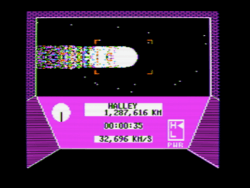The Halley Project
| The Halley Project | |
|---|---|
 | |
| Developer(s) | Tom Snyder |
| Publisher(s) | Mindscape |
| Designer(s) |
Omar Khudari Tom Snyder |
| Programmer(s) | Apple, C64, and Amiga versions by Leonard Bertoni |
| Platform(s) | Apple II, Atari 8-bit, C64, Amiga |
| Release date(s) | 1985 |
| Genre(s) | Simulation |
| Mode(s) | Single player |
The Halley Project is game developed for the Apple II, Commodore 64, Atari 8-bit family, by Omar Khudari and Tom Snyder and published by Mindscape in 1985. It was ported to the Amiga with updated graphics in 1986.
Overview
In The Halley Project, the player assumes the role of a star pilot whose mission is to travel between the various bodies of the solar system. The game opens with a mix of electric guitar music and actual digitized speech — a considerable feat considering the limitations of the Apple II — during which the player is shown the text of a transmission sent from the headquarters of a body known as "P.L.A.N.E.T.":
Greetings,
You have been chosen from all the pilots in the Solar System to attempt to qualify for The Halley Project team. If you do indeed qualify, you will be invited to take part in the greatest scientific adventure in history: The Halley Project ... the Final Challenge.
Good luck, you will need it.
Neal "Buzz" Collins
Starbird 1st Class
P.L.A.N.E.T. out
The player starts out from a base on Halley's Comet and must first make his way to Earth, and then back to Halley. As longer and more difficult missions are completed, the player's rank increases from the starting level of Raven through Shrike, Vulture, Darter, Condor, Swift, Nighthawk, Falcon, Eagle, and finally Starbird.
A secret mission at the end of the game is accessible by typing in a password mailed by the software company after the player completes the last registered mission and receives a number code. The code is then mailed to "Project Halley" (in reality the software company that designed the game) on a pre-packaged postcard. A letter is then received from the software company instructing the player to load the program, initiate the Starbird level, go to Earth, and type MINDSCAPE to access the secret mission.[1]
Description
The Halley Project is distinctive for the accuracy and sense of realism it seeks to convey. The distances between worlds are realistic, their sizes reasonably accurate, and the task of landing safely often less than easy — a small window at a certain point in orbit must be reached in a given amount of time. Travel across the vast distances of the solar system is made bearable by one of the game's few fictional elements, a hyperdrive that engages when the speed of the craft reaches 300,000 kilometers per second (the speed of light). Navigation takes place entirely in a flat plane with no "vertical" component, though the direction the ship travels and the direction it faces are each controlled separately. The player is aided by a radar system that pinpoints the planets on a circular display centered on the ship's position, around which are also marked the 12 constellations of the Zodiac. The range of the radar can be zoomed from 50 million kilometers out to 10 billion.
Reception
A review in Computer Gaming World praised the game for seamlessly weaving educational material about the solar system into the game. The game's scoring system, which imposes no penalty for taking time to plan a flight, was also praised, as were the visuals and sounds. However, the five-week wait for the final mission was considered frustrating.[2][3]
References
- ↑ "Halley Project". Retrieved 29 January 2015.
- ↑ Gregg, Williams (March 1986), "The Halley Project" (PDF), Computer Gaming World, pp. 24–27, retrieved 28 January 2015
- ↑ Miller, George (December 1985). "The Halley Project:A Mission in our Solar System". Compute! Gazette. pp. 108–112. Retrieved 28 January 2015.